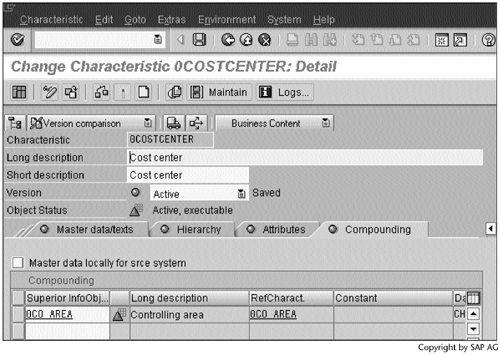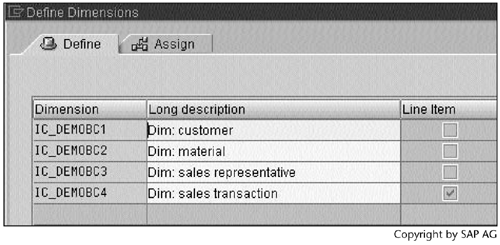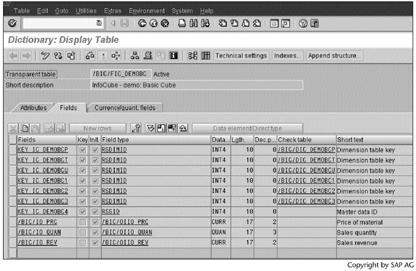Other InfoCube Design Techniques
Before closing this chapter, let's briefly discuss two other InfoCube design techniques:
- Compound attributes
- Line item dimensions
7.5.1 Compound Attributes
Compounding entities is an idea that BW borrows from R/3 to model coexistent entities. Compound attributes requires overhead, so you should not use them unless absolutely necessary.
Screen 7.38 shows that 0CO_AREA is a compound attribute of 0COSTCENTER as defined in Business Content.
SCREEN 7.38

Sometimes the meaning of master data depends on the source of the data. In these cases, we need to compound the characteristic with the InfoObject 0SOURSYSTEM (Source system ID).
For example, suppose a characteristic IO_HOUSE has an entry called White House. The characteristic could mean the home of the U.S. President if it comes from a government source system, or it could mean a house painted white if it comes from a home improvement Web site. To handle cases such as this one, we need to compound IO_HOUSE with 0SOURCESYSTEM to clarify the meaning of the characteristic.
The 0SOURSYSTEM InfoObject is provided with Business Content.
7.5.2 Line Item Dimensions
If a dimension has only one characteristic, we can make the dimension become a line item dimension. Consider the following example. For the InfoCube described in Chapter 2, we can create another dimension called Dim: sales transaction, and check the option Line Item as shown in Screen 7.39.
SCREEN 7.39

After checking and activating the InfoCube, Screen 7.40 reveals that the fact table has no dimension table created for the line item dimension. The key in the fact table is the SID of the SID table. Thus the fact table links to the master data, text, and hierarchy tables with the SID table, and one middle layer for the dimension table is removed. This design improves system performance.
SCREEN 7.40

Note
The line item dimension derives its name from the need for detailed information reporting at the line item level. In Chapter 9, Operational Data Store (ODS), we will discuss another technique that allows us to build a multilayer structure for different levels of detail information reporting.
The level of detail found in a data warehouse is called its granularity. It is determined by business requirements and technology capabilities.
Part I. Guided Tours
Business Scenario and SAP BW
- Business Scenario and SAP BW
- Sales Analysis A Business Scenario
- Basic Concept of Data Warehousing
- BW An SAP Data Warehousing Solution
- Summary
Creating an InfoCube
- Creating an InfoCube
- Creating an InfoArea
- Creating InfoObject Catalogs
- Creating InfoObjects Characteristics
- Creating InfoObjects Key Figures
- Creating an InfoCube
- Summary
Loading Data into the InfoCube
- Loading Data into the InfoCube
- Creating a Source System
- Creating an Application Component
- Creating an InfoSource for Characteristic Data
- Creating InfoPackages to Load Characteristic Data
- Checking Loaded Characteristic Data
- Entering the Master Data, Text, and Hierarchy Manually
- Creating an InfoSource for Transaction Data
- Creating Update Rules for the InfoCube
- Create an InfoPackage to Load Transaction Data
- Summary
Checking Data Quality
- Checking Data Quality
- Checking InfoCube Contents
- Using BW Monitor
- Using the Persistent Staging Area (PSA)
- Summary
Creating Queries and Workbooks
- Creating Queries and Workbooks
- Creating a Query Using BEx Analyzer
- Organizing Workbooks Using BEx Browser
- Using a Variable to Access a Hierarchy Node Directly
- Summary
Managing User Authorization
- Managing User Authorization
- Creating an Authorization Profile Using Profile Generator
- Creating an Authorization Object to Control User Access to the InfoCube Data
- Integrating Profile Generator and BEx Browser
- Summary
Part II. Advanced Topics
InfoCube Design
- InfoCube Design
- BW Star Schema
- InfoCube Design Alternative I Time-Dependent Navigational Attributes
- InfoCube Design Alternative II-Dimension Characteristics
- InfoCube Design Alternative III Time-Dependent Entire Hierarchies
- Other InfoCube Design Techniques
- Summary
Aggregates and Multi-Cubes
Operational Data Store (ODS)
- Operational Data Store (ODS)
- Creating an ODS Object
- Preparing to Load Data into the ODS Object, Then into an InfoCube
- Loading Data into the ODS Object
- Loading Data into the InfoCube
- Using 0RECORDMODE for Delta Load
- Summary
Business Content
- Business Content
- Creating an R/3 Source System
- Transferring R/3 Global Settings
- Replicating R/3 DataSources
- Installing Business Content Objects and Loading R/3 Data
- Summary
Generic R/3 Data Extraction
- Generic R/3 Data Extraction
- Creating Views in R/3
- Creating DataSources in R/3 and Replicating Them to BW
- Creating a Characteristic in BW
- Loading Data from R/3 into BW
- Summary
Data Maintenance
Performance Tuning
- Performance Tuning
- BW Statistics
- System Administration Assistant
- Tuning Query Performance
- Tuning Load Performance
- Summary
Object Transport
Appendix A. BW Implementation Methodology
Object Transport
Appendix B. SAP Basis Overview
Object Transport
- Object Transport
- Section B.1. SAP Basis 3-Tier Architecture
- Section B.2. Dispatcher, Work Processes, and Services
- Section B.3. Memory Management
Appendix C. Glossary
Appendix D. Bibliography
EAN: N/A
Pages: 106
